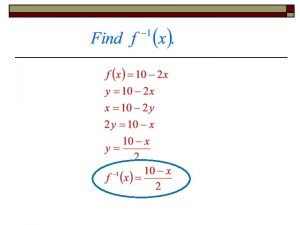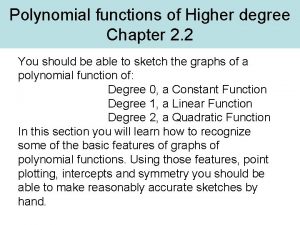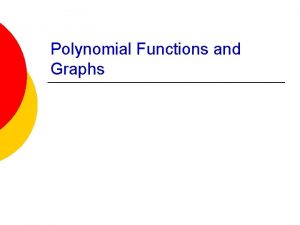2 2 Polynomial Functions of Higher Degree Note







- Slides: 7

2. 2 Polynomial Functions of Higher Degree Note: We will be talking about continuous functions in 3. 2 f(x) = axn where n If n is odd and a > 0, then f(x) will end in Quad’s I & III If n is odd and a < 0, then f(x) will end in Quad’s II & IV If n is even and a > 0, then f(x) will end in Quad’s I & II If n is even and a < 0, then f(x) will end in Quad’s III & IV


What quadrants will the following functions finish in? f(x) = -x 3 +4 x II & IV f(x) = x 4 – 5 x 2 + 4 I & II f(x) = x 5 – x I & III f(x) = -x 2 + 4 x - 7 III & IV

A zero of a function f is an x-value for which f(x) = 0. In other words, zeros are the x-intercepts or solutions of the polynomial f(x) = 0. Ex. Find the real zeros of f(x) = x 3 – x 2 – 2 x x 3 x 2 0 = – – 2 x 0 = x(x 2 – x – 2) 0 = x(x – 2)(x + 1) 0, 2, -1 are the real zeros. + x 3 means it ends in what quadrants? I, III Graph

Ex. Find the real zeros of f(x) = -2 x 4 + 2 x 2 0 = -2 x 2(x 2 – 1) 0 = -2 x 2(x – 1)(x + 1) zeros 0, 1, -1 what quadrants does a -x 4 end up in? III, IV

Ex. Find a polynomial with the given zeros. a. -2, -1, 1, 2 f(x) = (x + 2)(x + 1)(x – 2) Foil these first f(x) = (x 2 – 4)(x 2 – 1) f(x) = x 4 – 5 x 2 + 4 b. -1/2, 3, 3 f(x) = (2 x + 1)(x – 3) f(x) = (2 x + 1)(x 2 – 6 x + 9) f(x) = 2 x 3 – 11 x 2 + 12 x + 9 (x + ½) or (2 x + 1)

Use the Intermediate Value Theorem to approximate the real zero of f(x) = x 3 – x 2 + 1 Use graphing calculator to graph f(x) and then use the table to find the zero.













